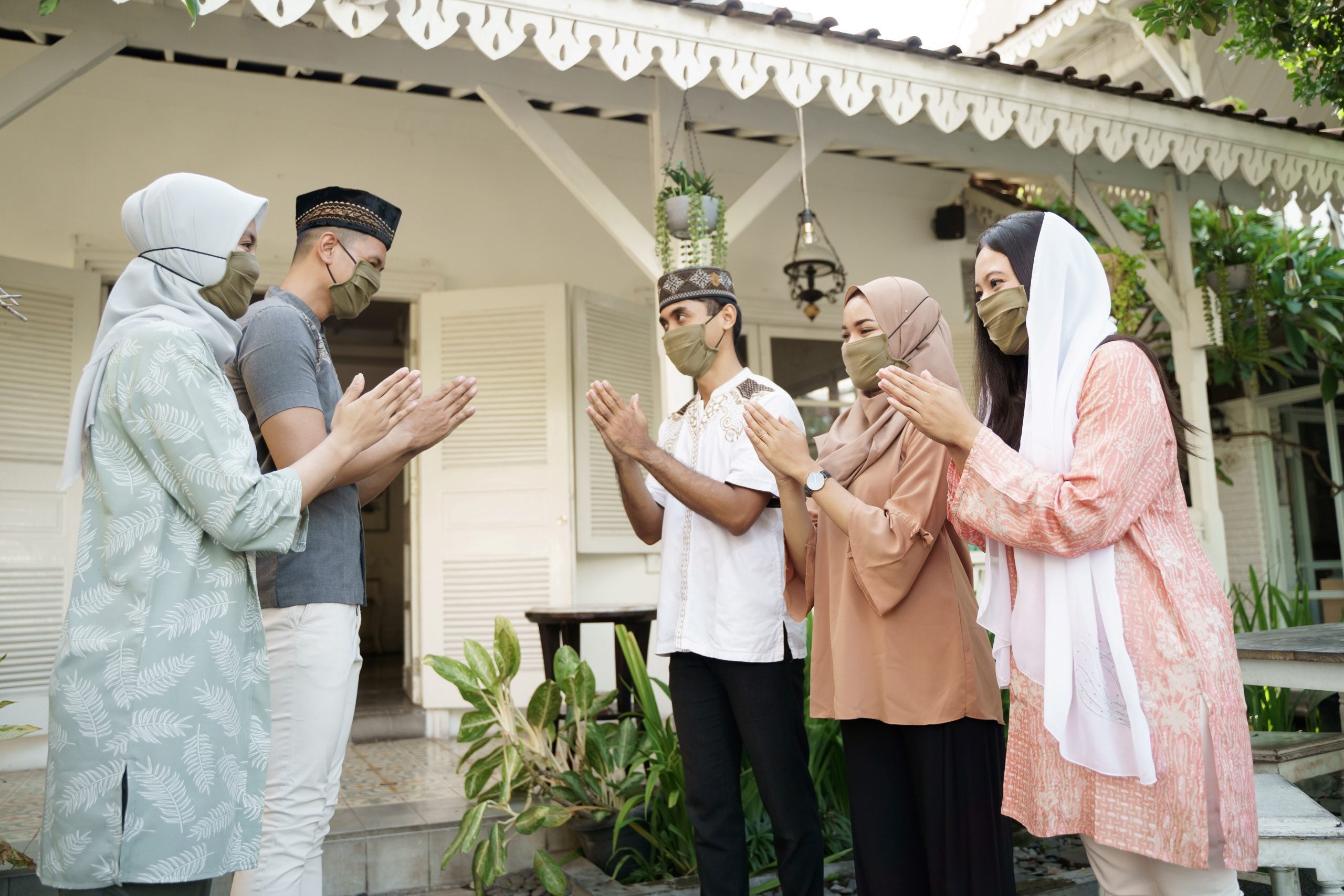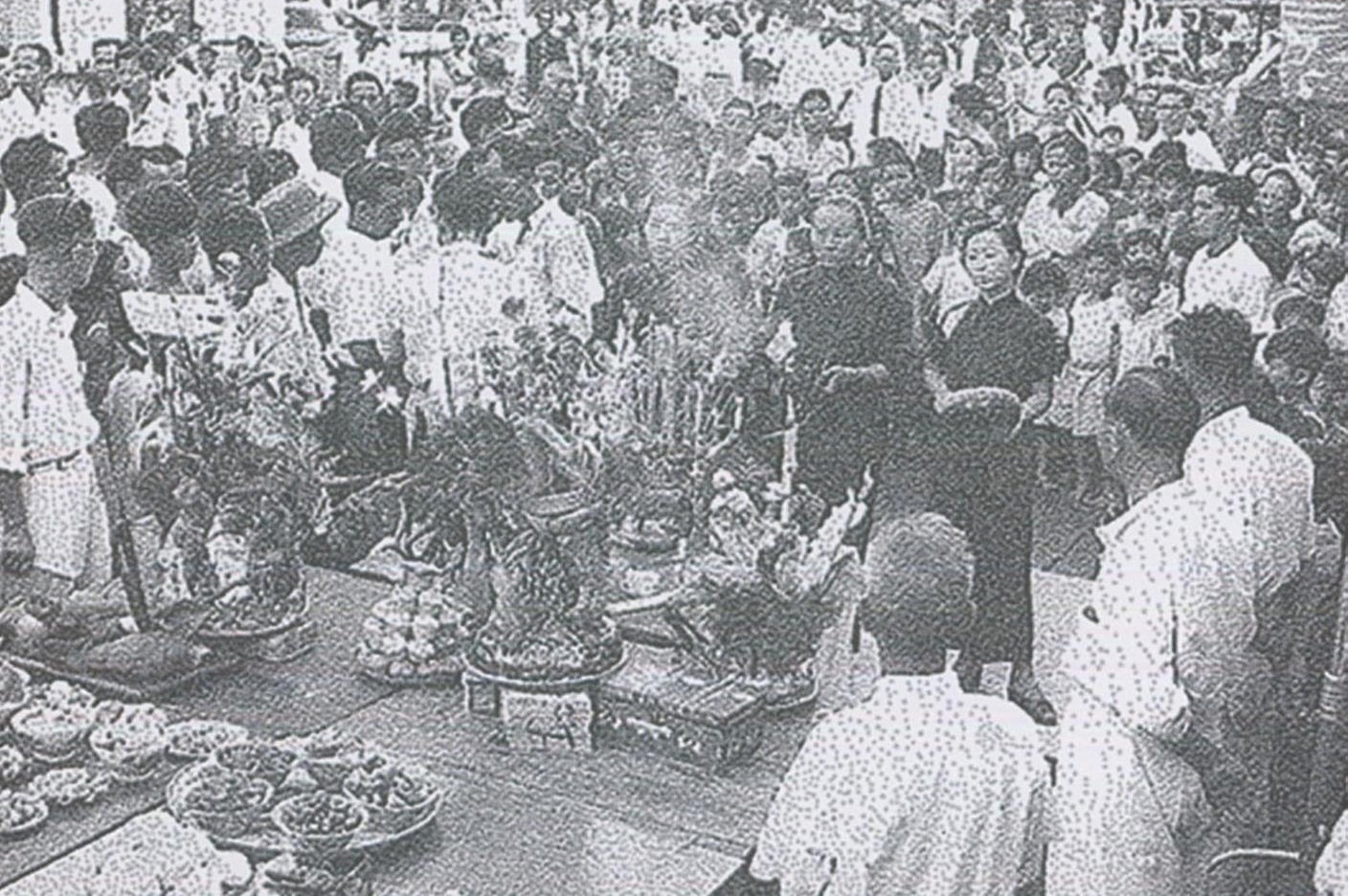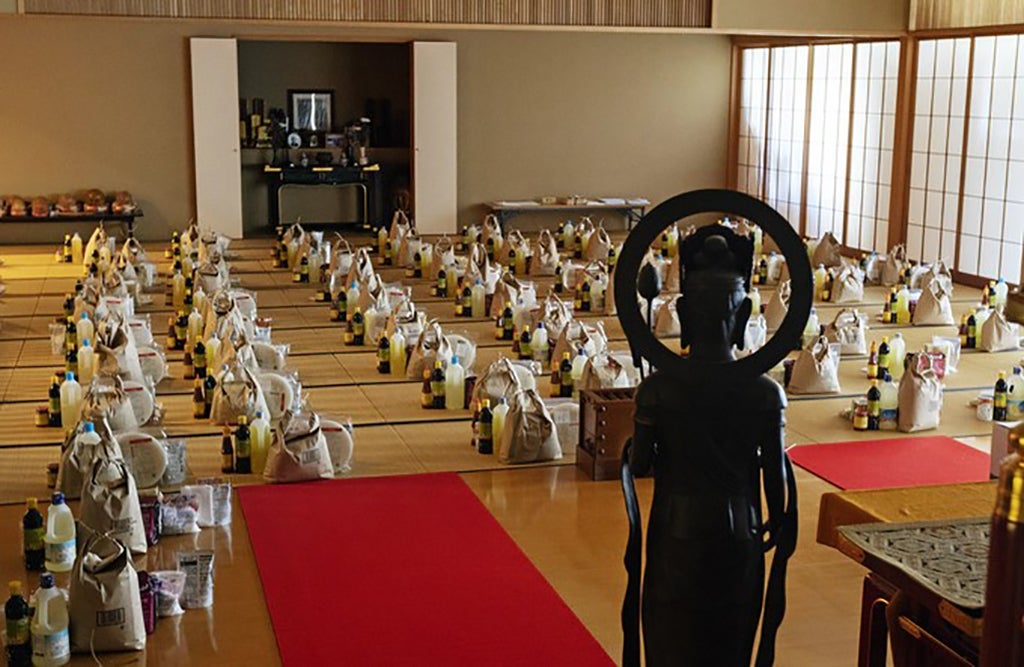Prayers, Protocols and Pandemics, Part 3 - Josspaper Vaccinations and Re-configurations of Religious Spaces in Malaysia and Singapore
contributed by Soh Chuah Meng Esmond, 1 September 2021
I have previously written two short essays on this platform documenting the impact of COVID-19 on the hosting of the Seventh Lunar Celebrations (aka the “Ghost Festival”) in Singapore, and to a smaller extent Malaysia. In this short article, I present two present-day case studies to demonstrate how the occasion had continued to function as a nexus and barometer of state-society relations in these two countries.
The Case of the “Hell Covid-19 Vaccine” in Malaysia
A news story about how “spirits can get their jab too” showcases an entrepreneur who began selling “Hell Covid-19 Vaccine” josspaper offerings after he encountered customers who were saddened that their kin had passed away because of the disease. Although the the “Hell Covid-19 Vaccine” offerings are ostensible meant for “wandering spirits for the month-long Hungry Ghost Festival,” the cost (RM 30 and above) seems prohibitively high to be used for wandering ghosts, particularly when compared to the ordinary paper offerings that are typically presented to the unclaimed dead.
At face value, the article stands out as a piece of unimportant trivia. However, I suggest that the ‘invention’ and proliferation of the “Hell Covid-19 Vaccine” echoed my earlier findings on a similar issue, where I discussed the sale of effigy papier-mâché masks. On the one hand, the interviewee cum vendor presented his innovation as a means for the families of COVID-19’s many victims to seek catharsis in 2021, where the dead and their families were consoled by makeshift offerings instead of an actual vaccine that could have prevented their deaths.
On the other hand, we could also read the provision, sale, and implied-popularity of these vaccination offerings as a roundabout criticism about how the pandemic was handled in Malaysia. As of July 2021, the Delta variant – a more contagious variant of COVID-19–vigorously spread through Malaysia, infecting thousands of people and quickly raising the COVID-19 death rate. Probably uncoincidentally, the “Hell Covid-19 Vaccine” attracted journalistic scrutiny at – and entered the market concurrently with – an equally tumultuous phase of Malaysian political history, where the incumbent-caretaker prime minister (PM) Tan Sri Muhyiddin Yassin had just resigned from his official appointment a few days before.
These seemingly-independent forces – coupled with increasing dissatisfaction by Malaysians towards the country’s political morass – provide clues to contextualising the popularity of these josspaper innovations. While we can ‘read’ the provision of papier-mâché COVID-19 vaccinations literally as an expression of filial piety for one’s ancestors (and possibly public-mindedness for the less-fortunate) who had perished because of COVID-19, the socio-political context behind these ritual innovations point to a different hypothesis.
The proliferation and sale of such papier-mâché vaccines, although directed to otherworldly spirits, likely refracted this-worldly frustration about the inadequacy of practical and coordinated political responses towards the pandemic. When secular governments failed to control the pandemic by providing timely vaccinations, citizens who wanted “to fulfil their deceased loved ones’ wishes of getting the Covid-19 vaccine” were forced to offer posthumous substitutes to console their loved ones in the afterlife via spiritual means instead.
Drawing Lines: State and Spirit-Scapes in Present-Day Singapore
The second instance, like the first, takes us slightly back in time to July 2021 in Singapore, where the island-state had undergone a series of tightened movement restrictions because of the phase-2 Heightened Alert (HA) measures. In the wake of infections from the Jurong Fishery Port, authorities have enclosed hawker centers and markets in Singapore. Entrants were required to register their details at the entrances of these premises for contact-tracing before they were allowed entry via the TraceTogether application or token.
While this may not be universal across the board (given that I was only able to observe a few of such ceremonies by coincidence), I noticed that many Seventh Month associations (中元會/盂蘭盆會), their altars, and incense censers were either deliberately situated outside of these state-defined parameters of where wet markets and hawker center “begun” and “ended,” or shifted in recognition of these redrawn boundaries. Such associations are ephemeral components and a common sight in urban Singapore, and many of them disappear – with the ash and smoke that mark their beginning – by the end of the said-month.

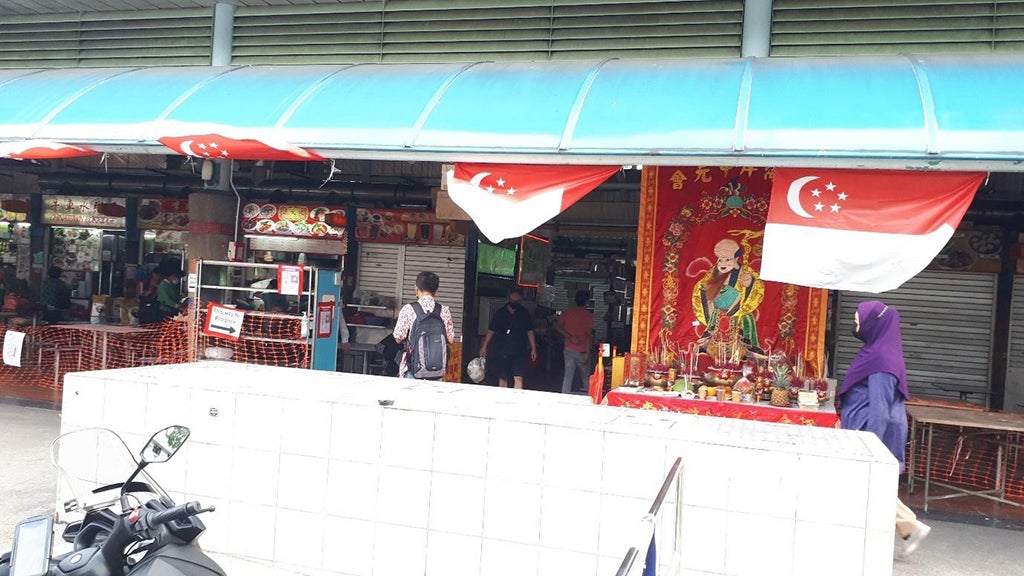
Figures 1 and 2: The West Coast Seventh Month Association at the Ayer Rajah Food Center. Note the TraceTogether scanner for tokens and the application at the left side of the altar, as well as the orange webbing that had been used to ‘separate’ the hawker center from its surroundings. Also see the ‘gateway’ into the hawker center and the adjacent position of the temporary altar right outside of the said-entrance in Figure 2. Photographs by the author, August 2021.
State and societal actors, as Lily Kong had noted in an earlier study, were continuously involved in the negotiation and re-definition of religious spaces, and the fencing of hawker centers and markets – and the clear designation of entrances and exits in contrast to the open floor plan of many such associations – in the wake of such regulations testified to the continued salience of Kong’s observation. The case of the Ayer Rajah hawker center in the western part of Singapore demonstrated this most clearly, where the Seventh Month Association for West Coast Road and its temporary altar was situated at the entrance and exits of these premises (Figures 1 and 2).
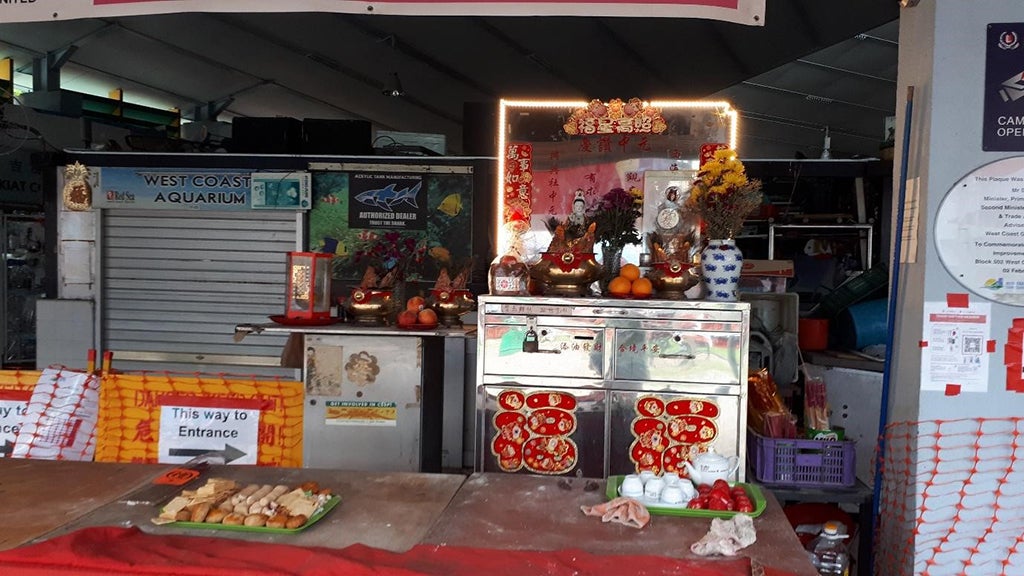
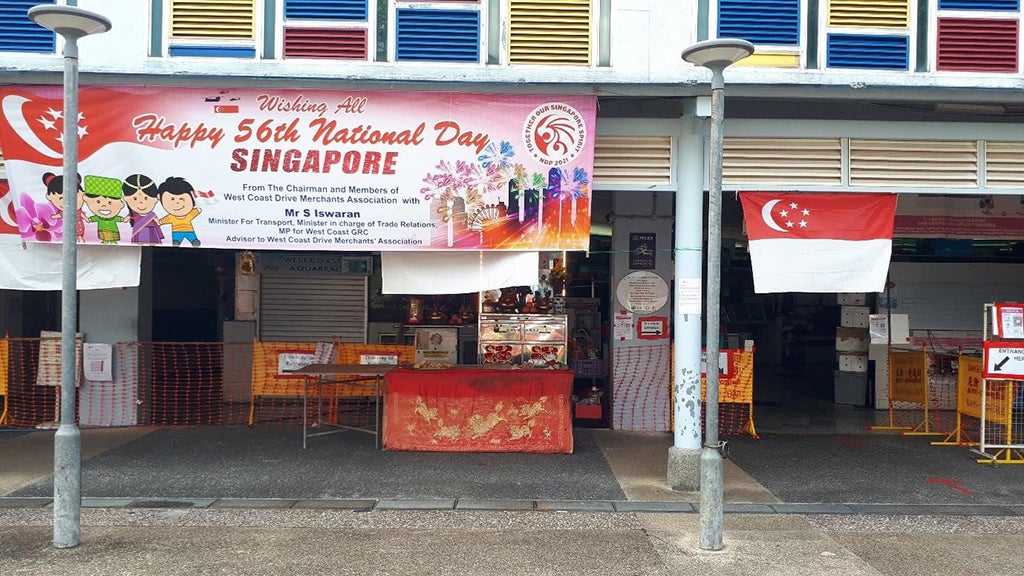
Figures 3 and 4: The Xing Xing Association (興興社中元會) located outside of the Ayer Rajah Wet Market. Note how the altar – like the cases of figures 1 and 2 – were located outside of the market as designated by the orange webbing. Note the TraceTogether scanner for tokens and the application at the entrance. Photographs by the author, August 2021.
The same went for the Xing Xing Association (興興社中元會) in the adjacent Ayer Rajah market. Figures 3 and 4, for example, show how these altars were located without the very compounds that organised such events, and how state-maintained boundaries were used as a heuristic in the process. The store holders from the market were involved in running and maintenance of the association (as seen from the red banners that detailed the incense-censer keeping roles played by some vendors in Figures 5 and 6), but they had situated the heart of the Association’s activities squarely outside of their own place of businesses.
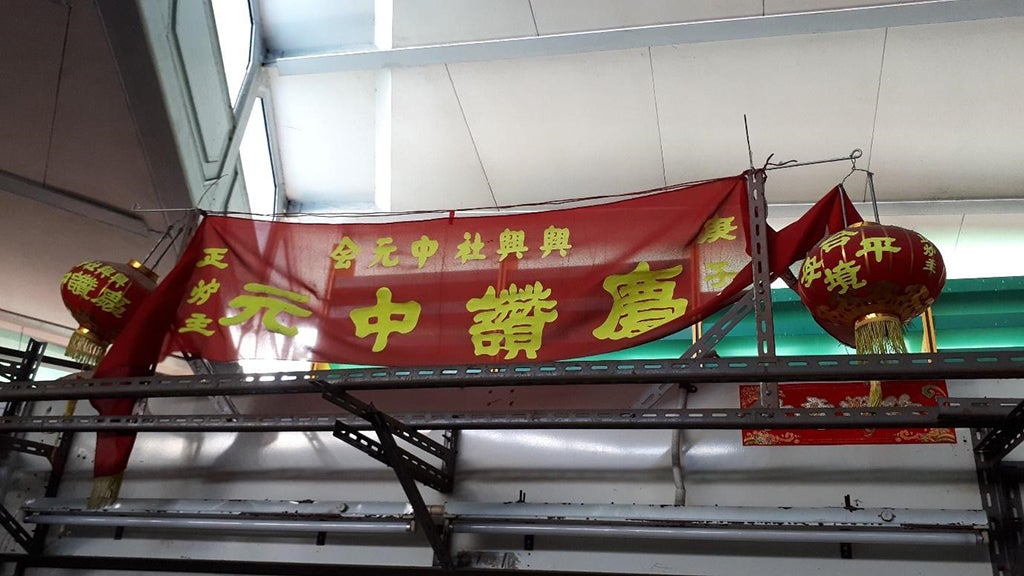
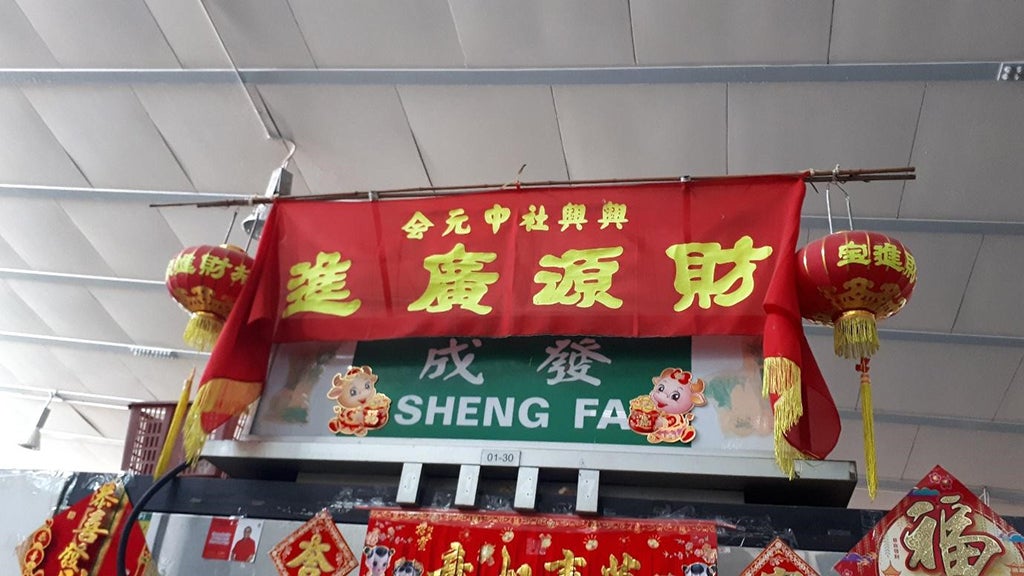
Figures 5 and 6: Ang cai (Mandarin: Hong cai; 紅彩) viz. “Red Banners” hung above the signboards of various stalls located in the Ayer Rajah Wet Market. The owner of the first ang cai was the “head censer-master” for the Xing Xing Association. Photographs by the author, August 2021.
Figure 7, taken in Ang Mo Kio, likewise demonstrated how the norm of hosting the “good brothers and sisters” continued with the help of foldable tables and plastic chairs. This, however, only took place for the span of a communal ritual, and such an exceptional arrangement was located against an equally-unusual background, where tables and stools outside of a hawker centre’s designated space were cling-wrapped beforehand to prevent human diners from using them. The awkward juxtaposition of these short-lived “aesthetic markers and aesthetic anchoring” against their misanthropic backdrop testified to the temporary subversion of the ‘norm’ in two ways: Ghosts were feasted in dining areas where men were forbidden to do so now because of state regulations imposed to stem the spread of COVID-19. In a very real sense, these ghosts were temporarily more free than Singaporean citizens to move around in public.

Figure 7: Two temporary tables of food offerings offered by a seventh month association attached to a hawker center in Ang Mo Kio, Singapore. Note how the two folding tables in the foreground had tablecloths, and stood in contrast to other tables and chairs that were cling-wrapped and covered with caution tape. Photograph by the author, August 2021.

Figure 8: A different angle of the same area as per figure 7. Note the disappearance of the two temporary tables at the end of the communal worship ceremony held in the afternoon, as well as the temporary altar in the center-background of this photograph. Photograph by the author, taken five hours after figure 7, August 2021.
As Adam Yuet-Chau had noted, religious festivities – regardless of their presiding divinity or purpose – were ultimately social functions that were organised, executed, and hosted by this-worldly human agents. The propitiation of these netherworldly visitors, although a religious centrepiece and highlight for many of the older neighbourhoods in Singapore, could be conceptualised along analogous lines of insiders-cum-hosts (the shopkeepers and residents who contributed financial clout and manpower to the occasion) and outsiders-cum-guests (wandering spirits who partook in the food and josspaper offerings presented to them by their human sponsors). Many of these areas have re-aligned – deliberately, or coincidentally – along the lines that were carved into the landscape by regulators. Figure 9, for example, demonstrated how one such altar was distinctively positioned outside of the webbing that had been wrapped around the pillars of one such hawker center in Ang Mo Kio.

Figure 9: Ritual space dedicated to the Seventh Month Association attached to a hawker center in Ang Mo Kio, Singapore. Like figures 1-4, this altar was (conveniently?) located outside of the webbing that was wrapped around the hawker center because of Heightened Alert (HA) measures that were implemented since July 2021. Photograph by the author, taken five hours after figure 7, August 2021.
The demarcation of sacred space by the human hosts of Seventh Lunar Month festivities in several of Singapore’s hawker centers and markets confirms Robert Weller’s hypothesis after he had observed many of such occasions in Taiwan: Although ghosts deserved to be pitied and fed throughout the Seventh Lunar month festivities, they were ultimately strangers whose permanent presence within the community outside of the Seventh Lunar Month was minor, if not non-existent, at best. Arthur Wolf, likewise, compared ghosts to beggars in the Taiwanese communities that he observed: While families occasionally offered these vagrants charity in the form of cooked meals, they were never invited into the home, and took their meals separately at the family’s doorstep before departing.
Like beggars in Taiwan, ghosts were also seen as transient features of the landscape. While their fates deserved commiseration, their presence was certainly not welcome on a permanent basis, and the vast amounts of paper money that were burnt to see these supernatural ‘guests’ off testified to how these entities were meant to be sent away with gifts of cash. In many ways, this generalisation holds true for the Seventh Month Festivities in Singapore. Ghosts were served in a compound separate – and away – from the communities that hosted them, a task that had been facilitated by the demarcation of hawker centers and markets imposed by the state. Such organisations conveniently re-aligned and re-situated themselves along the contours determined by the state, and their marginal, liminal character testified to their location and exclusion from the human communities that supported them.
The two case studies presented here show how COVID-19 has influenced and shaped expressions of Chinese religiosity in Malaysia and Singapore. By focussing on the banality of such religious activities, I hope to shed more light on what these re-alignments could mean in a world that is preparing to exit the worst of COVID-19’s crippling effects as of the time of compiling this essay.
Disclaimer: The views and opinions expressed in this article are those of the authors and do not necessarily reflect the position of the blog editorial team or the Asia Research Institute.
South Asia | Southeast Asia | East Asia | Other Places | Hinduism | Buddhism | Islam | Christianity | Other Religions
Soh Chuah Meng Esmond is a History graduate student enrolled in the Master of Arts program at the Nanyang Technological University, School of Humanities (SoH), Singapore. His research interests include the history of religion, diasporic Chinese religion and the history of the overseas Chinese in Southeast Asia.
Other Interesting Topics
Seeking Solidarity: Rethinking the Muslim Community in the Pandemic Era
Ramadan has just ended, and it has been a very unsettling one, to say the least. So many aspects of our religious lives, one that is very much to the idea of the community, have to be readjusted. Though, as some would put it, physical distancing does..
Re-sensorializing Chinese Religion in Singapore?
The spread of coronavirus in Singapore and the social distancing measures implemented to stop the spread of the virus disrupted the balanced interaction between Chinese temples and their devotees, both socially and economically. Given the constraint of space...
Buddhist Temples as Shelters for Vietnamese Migrants in Japan under COVID-19 Conditions
When the Japanese economy faced depression in 2020, one of the most affected groups in Japanese society were the foreign workers. Shrinking economic activity resulted in layoffs, and foreign workers were the first employees to be dismissed from many companies. These retrenchments were disastrous for 80,000 Southeast Asians residing in Japan...


